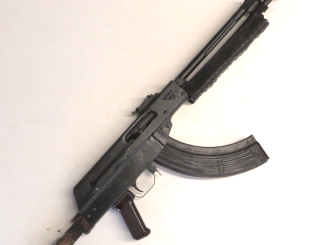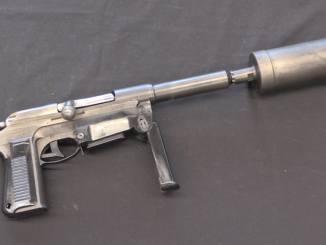When Polish workers held massive protests in Poznań against the communist Polish government in 1956, the Army was sent in to quell the unrest. In the aftermath of these events, the government decided to create a riot police squad to handle any future such situations. When this unit was put to use in the 1968 Student March, they found that hand-thrown tear gas could be thrown back into police ranks – and development began of tear gas launchers that would have a much longer range.
The final iteration of this program was the RWGŁ-3, made using as many AK parts as possible for cost-efficient production. It was essentially a stamped-receiver AK with no gas system and a gas launching cup in place of a barrel. A pair of AK grips allowed the user to control the not-insubstantial recoil coming from a full-power 7.62x39mm blank cartridge. It fed from a 10-round AK magazine blocked to fit only (well, mostly only) blank 7.62x39mm cartridges. The result was a launcher that would heave a tear gas grenade substantially farther than it could be thrown by hand. The RWGL-3 was put into substantial production, and exported widely across the Warsaw Pact and aligned nations.
Many thanks to Works 11 for giving me access to film this very cool rare item for you! Further thanks to Leszek Erenfeicht for his assistance sourcing the photographs in the video.




Hi,
Only now in the video I have noticed that this RWGŁ-3’s serial is starting with “SZO”, indicating the Siatkowy Zestaw Obezwładniający, or Disabling Net (Throwing) Set. It is a part of an even more interesting contraption, with which you replace the tear gas grenade cup. It is a special conical attachment, into which nylon net with plastic weights is inserted, and by discharging the blank, you can throw – for a distance of 3-5 meters – a net, which is wrapping around the assailant, thus disabling him. The net package is held in the center, with plastic weights plugged into the radially set channels or vents, connected to the barrel. Upon a discharge of the grenade blank, the gases would expell the weights towards the target at a tangent, in a conical pattern, deploying the net and propelling it towards the target. The SZO-3 (then renamed SZO wz. 84) set was using the RWGŁ-3 launcher as a base, but were seldom used in reality, except for really CQB distances, and human targets rarely got that close – so it was mainly used for subduing the agressive animals. Finally most were converted bach to lachrymatory use, as this one was. Next time we go to Katowice, we should show the complete set – they sure have it.
Check out https://www.wykop.pl/link/2978671/japonska-bron-do-samoobrony/strona/2/ – ignore the video link, go straight down ito Comments and there, right under the Spiderman cartoons, you’ll find a still from the SZO training video, and then a photo of the SZO-84 ready to use.
https://forum.cartridgecollectors.org/t/pl-26mm-wkladka-redukcyjna-do-ps-wz-78-do-miotania-siatki-obezwladniajacej-26mm-reducer-adapter-to-ps-wz-78-for-throwing-exhaustion-net/28307 claims that Siatkowy Zestaw Obezwładniający wz.84 (SZO–84) was used together with signal pistol. Was that attachment universal and could be used with both RWGŁ-3 and signal pistol xor SZO wz. 84 and Siatkowy Zestaw Obezwładniający wz.84 (SZO–84) are totally unrelated design, each fitted for different weapon?
I don’t know who Works11 is, but don’t plan to riot against them.
>>The RWGL-3 was put into substantial production, and exported widely across the Warsaw Pact and aligned nations.<<
Not to the 'nations', but to their governments. The nations were targets!
🙂
Exactly correct.